Saint Johns School Changes the Name of its Mascot
Rick Archer, April 2004
Last Update: February 2007
As part of my business, I frequently write stories and articles
for my dance studio web site. Thanks to the Internet, the SSQQ Newsletter
and the SSQQ Web Site
have served a key part in the expansion of my business. I
write stories about the studio and see interest about the studio's
activities increase in the process.
As a result, I have turned into something of a writer these past few
years.
I get some nice compliments from time to time on my stories.
People say I am an excellent writer and are impressed with my vocabulary. I tell
these people without hesitation that I owe these skills to the
magnificent education I received at Saint John's School
here in
Houston. And I mean it - this school is
incredible.
I went to Saint Johns from 1959 till graduation in 1968. To
this day I consider the education I received from SJS
to be the single
biggest break I received in my entire life.
Saints Johns bills itself as a College Prep School
and I assure you that they deliver on their promise. If you have a gifted child, Saint Johns is without a doubt the place
to send your son or daughter.
Your child will receive the finest education imaginable
at Saint Johns. Not only will your child benefit immeasurably from
competing day in and day out against other children with equal
talents, he or she will be taught by a talented staff at Saint Johns.
The education is so thorough that as graduation
approaches, your son or daughter will have a terrific chance
of being accepted at Rice, Stanford, Vanderbilt,
plus any of the amazing
Ivy League schools.
That is the kind of education that Saint Johns is
famous for here in Houston.
Saint John's is steeped in tradition.
It is located in River Oaks, the home base for Houston's power
elite over the past century.
William and Michael Hogg, sons of former Texas
Governor Jim Hogg, and attorney Hugh Potter established River Oaks
in the 1920s.
Over time, River Oaks has become one of the
wealthiest communities not just in Texas, but the entire United
States.
Today
the location of River Oaks is considered "Inner City",
but it is amusing to note just how deserted much of the area was
back in the beginning of the school.
Saint Johns School was founded in 1946
shortly after World War II. 1946 was a big
year for Houston; coincidentally that is the year the Texas Medical
Center was founded as well. As you can see, that area was once
deserted as well.
Saint John's was located in the heart of River Oaks on the corner of
Westheimer and the oddly named Buffalo Speedway.
If you look at this 1921 map, there is a curious oval track where
Alabama Street is now. That spot appears to located across the
street from today's Lamar High School.
From what I gather, that oval was an actual
raceway out on the prairie on the western tip of Houston.
Hence the name Buffalo Speedway.
As for the mighty Westheimer Street, back in
1946, Westheimer
was little more than a mud road to nowhere which led primarily
to farmland. Today Westheimer is a major Houston artery.
As Houston has grown, so has
Saint Johns.
Over the past 60 years, many children of
Houston's business and political leaders have been trained at Saint
John's. Consequently any of Houston's current leaders can
point to an SJS education as the secret of their success.
And from the ranks of SJS graduates come many
fine doctors, lawyers, and engineers. SJS can even point to
several movie makers as well.
As its graduates reach the point in life where they
can contribute to the building fund, Saint John's continues to
gobble up surrounding real estate the moment it becomes available.
The school continues to grow both in prestige and size.
It is hard to believe, but to current Saint
John's students, this picture from the 1968 yearbook will surely
seem pretty weird. Look how small the school was back then!
No kidding. When I graduated in 1968, there were only 50
students in my graduating
class and perhaps 220 in the entire upper school.
Today in the 2000s,
Saint John's is easily twice that size in acreage and
enrollment. Over the years, Saint John's has become
recognized as one of the finest college prep schools in the
entire country, a high honor indeed.
|
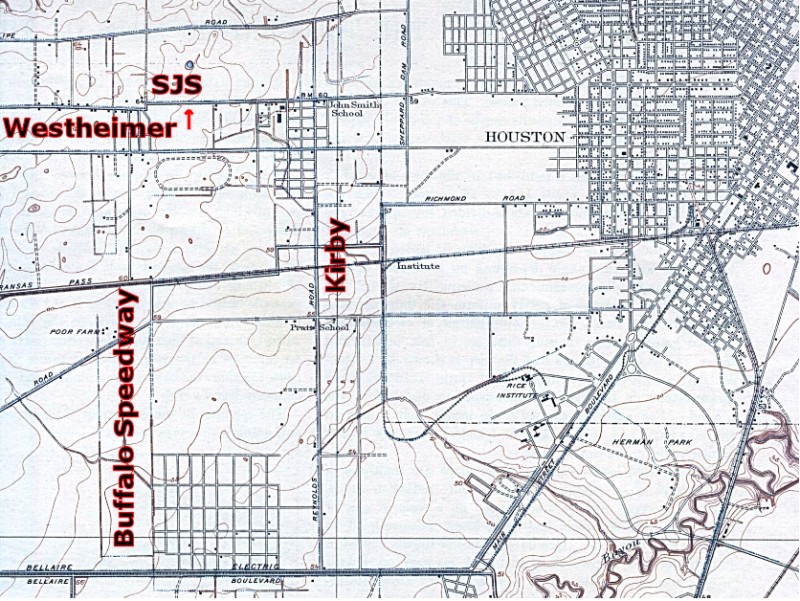
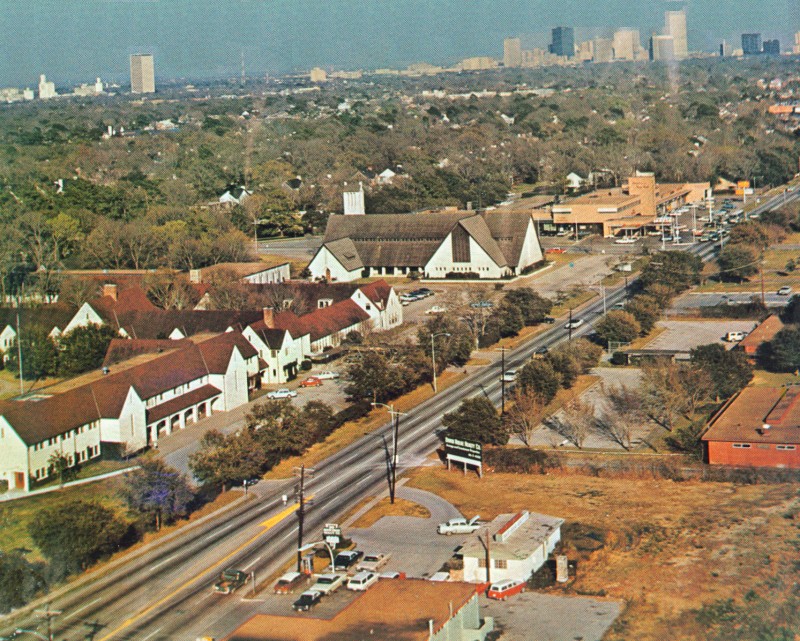 |
As one might expect, Saint
John's is very expensive. Saint
John's was relatively inexpensive back in my day with tuition set at
$1,000 a year. Saint Johns cost in the area of $15,000 a
year the last time I checked in 2004.
I think that has now increased to over
$20,000. Good grief.
Amazingly, money is usually not an obstacle.
Typically the
students St John's are the children of Houston's wealthiest
citizens who can well afford the tuition. In
addition, Saint Johns definitely goes out of
its way to find scholarship money for any student smart enough to
handle its curriculum, but whose parents may not be
able to foot the entire bill.
I should know. I was fortunate to receive partial scholarships for the
7th and 8th grade. As a reward for
consistently making the Honor Roll, I was then given a full scholarship through high school.
Saint John's is very generous.
I have already explained how grateful I am
for my Saint Johns
education, but there is more to the story. Saint Johns
did more than simply teach me reading, writing, and arithmetic.
Although this place is scorned
by some as catering only to the rich, I know from first-hand
experience this school has a big heart too.
Due to my broken home, I was a very angry
kid. I was always getting into trouble and fought their
discipline tooth and nail. Thank
goodness the administration showed infinite patience with me.
I believe that my teachers saw that under my thin skin I was
really trying hard to succeed at their school.
I can think of a dozen different mentors who played a roll in
guiding a potential delinquent toward a more constructive path (read
the story about Mrs. Ballantyne). I
owe much of my success in life to the education and guidance I
received at SJS.
As one might gather, thanks to all the help I received, I developed an intense loyalty towards my school.
THE MASCOT DILEMMA OF THE ST JOHNS REBELS
Despite its remarkable accomplishments in the academic arena
and the remarkable decency of the people responsible for Saint John's
many years of success, there
was once a bizarre stigma
that was allowed to persist at Saint Johns for over 50 years.
Did you know the Saint John's mascot was a "Rebel"?
We
are not talking 1950's
James Dean here.
Nor a 1776 Colonial Revolutionary either. Our Rebel was a
Confederate general straight from the Civil War.
During the years I went to Saint Johns, the
school yearbook was known as "The Rebel".
The theater program
that put on the plays and musicals was known as
"Johnnycakes".
Leaving nothing to
the imagination, during the Sixties,
a huge, larger than life statue
of a Confederate general was trotted out at the football games.
The statue was known as "Johnny
Reb". "Johnny Reb" was the
school's official symbol.
|
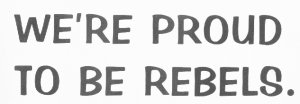 |
The phrase "We're Proud to be Rebels"
was taken from the 1968 Rebel yearbook. It was the unofficial motto
of the school.
Now that I think
about it, I was proud to be a Rebel. I
was proud of my school and proud to be a student there.
If you want to know the truth, I actually liked the
nickname. I was about as rebellious as they come.
Hence the nickname worked well for me. I only grew
uncomfortable when they trotted the statue out at
football games. I would just look the other way.
|
|
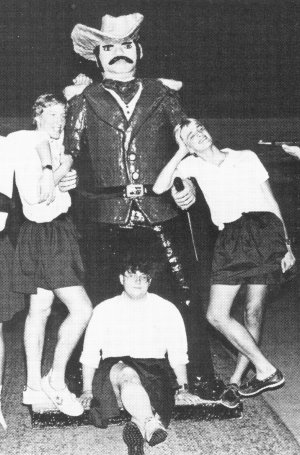 |
My Years at Saint John's
Looking back, I guess I feel sheepish that
I never raised much more than an eyebrow at the implications of
the "Rebel" mascot during my time at the school. I
was immersed in an all-white culture and far more concerned with
graduation than racial injustice.
It never actually occurred to me, but
Saint John's did not have a "Rebel" logo that I was
aware of. In other words, there was no artwork of
a Rebel that appeared on any stationary. Nor were
there any Civil War paintings on the walls.
Had there been images such as the
infamous Ole Miss Rebel logo, things might have been
different.
I don't know if this was deliberate
or accidental, but the lack of any logo helped to keep
the issue in the background.
Since there were absolutely no
day-to-day images of any 'Fightin' Johnny Rebel' to bring the issue to
the surface, I didn't give the name any thought. As long as
they kept that giant Johnny Reb statue out of sight (which they
did for the most part), I never
gave the Rebel nickname a second thought.
If forced to explain my do-nothing
conscience, I definitely think the fact that there were
no blacks at the school made it much easier for me to
look the other way. I certainly understood the
Rebel mascot would have been offensive to blacks, but
since I had no black classmates or black faculty
members, there was no one to offend.
If it doesn't hurt anyone, what
difference does it make? It never even
dawned on me that the African Americans who cleaned the
school and worked in the cafeteria might have had an
opinion.
I had a real blind spot on this issue.
Can I be honest here? I am
no better than anyone else. Don't even begin to
think of me as some lonely crusader crying in the
wilderness for justice and social equality. I
never raised my voice once.
|
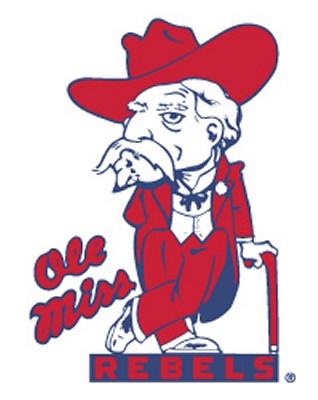 |
Like most people, I was a product of my
environment. For example, I disliked Aggies intensely.
Why? Because all my classmates disliked Aggies. Not
a day passed when I didn't hear a dismissive Aggie joke.
Not once did I ever question my bias. Not once did it ever
occur to me that no Aggie had ever done a mean thing to
me. I didn't even know any Aggies. No matter. I accepted my prejudice without
question. Aggies were someone to be made fun of.
For that matter, I was taught to dislike
anyone from Kinkaid, our bitter rival. It wasn't
till later in the life that I realized some of my favorite
people had graduated from none other than A&M. Another
"later in life lesson" was that I had a lot in common with the
Kinkaid graduates I met. Some of the most interesting people I
knew were Falcons.
On the other hand, my mother taught me to
respect people of all races and religions. I am grateful
to her for that.
We are all products of our environment.
I imagine that if I had been born and raised in the South just
prior to the Civil War, I would have fought on the side of the
South. I would have treated slaves poorly and felt
victimized by the evil Abraham Lincoln. When one realizes
how difficult it is to remove the blinders created by the
culture one grows up in, it is a humbling experience. At
this point, it
becomes much harder to point fingers and pretend to be better
than anyone else.
Mark Twain once said, "Travel is
fatal to prejudice, bigotry and narrow mindedness... Travel
helps us discover we are a family after all."
Amen to that.
Here's a simple example of how one's
environment can influence one's attitudes. I had a 30 year
career running a dance studio. Thanks in large part to the
movie Urban Cowboy, here in Houston, Country-Western
dancing is not only popular, it can be very flashy with lots of
turns and spins. Plus it is common for men to dance
backwards at various times. Western dancing can be a lot
more sophisticated than one might guess.
One day in 1984, a girl friend took me to
Cuero, Texas, to visit her parents. That night we went
dancing at the local VFW hall. I stared in shock as the
men made sure their women did nothing else but dance backwards
for the entire night. No spins, no turns, no men going
backwards.
I asked Jeff, my girlfriend's brother
about it. Jeff said, "These men have trained their women
to go backwards for a hundred years. That's the way its
done here in Cuero. And if you want to leave this place
without a hassle, I suggest you make my sister go backwards for
the rest of the night." Noting the hostile stares
directed at me, I followed Jeff's suggestion to the letter.
That was their tradition in Cuero.
If someone is stuck in
one place with little outside influence, as the Country-Western
song
goes, don't go risin' above your raisin'.
When it comes to 'prejudice', it is one thing to see
injustice and do nothing
about it. It is quite another thing to not recognize the
injustice in the first place. When one is surrounded by a
limited point of reference, it becomes very difficult to see the
larger picture.
There was no obvious 'prejudice' at Saint
John's that I was aware of that might prick my conscience.
Yeah, my school had a questionable mascot, but it wasn't hurting
anyone. In the total absence of any dissent, I accepted
the Rebel mascot just like the rest of my community did.
That's just the way we do things around here.
The Rebel nickname had been adopted a long
time before Martin Luther King and the Civil Rights
Movement of the 60s. The Rebel mascot was
definitely a reflection of Houston's
prevalent social consciousness at the time.
Houston was never as racist as Alabama or Mississippi, but
let's not bury our heads in the sand. Texas had fought for
the Confederacy and still had its pervasive share
of lingering bigotry and prejudice. It was no surprise that Houston
had its share of
racist attitudes as well.
One would think that during the
Sixties there was
enough blood shed in race riots and
police confrontations to make anyone with a brain
and a conscience flinch about keeping "Johnny Reb" as
the school mascot. But
my head was buried in the sand. I never paid much
attention to those headlines. My classmates and I
were largely shielded from the changes taking place in
society. We lived in the Land that Time forgot.
As I have said, in nine years at Saints Johns,
I never noticed any instance of racial prejudice. Neither my classmates nor the faculty said
much of anything on the subject. I don't recall a
single word about race ever taking place in class or in
casual conversation. Consequently I never felt my school was
prejudiced.
That said,
some schools were obviously well ahead of Saint John's
on the issue of integration. For example, our
athletic teams faced black athletes from other schools.
There is a picture in my 1968 yearbook of an SJS
basketball player attempting a layup against a black
athlete. To the credit of the SJS athletes, I
never heard any negative words spoken about their black
opponents.
Unfortunately I never
questioned why some schools had black students and Saint
John's didn't.
Yet at the same time, I
felt the people at Saint John's were extremely
open-minded. For example, I had several Jewish classmates
who were completely accepted at the school. To my
knowledge, they were never discriminated against. So we
clearly had religious tolerance.
Furthermore, the girls were treated with total respect
in an era long before women's issues had begun to grab
headlines.
Not once did anyone ever suggest the girls tone it down so the
boys could gain more confidence. I can honestly say with a
wistful smile the girls would regularly kick my butt in
class. Saint John's was light
years ahead of the curve in this regard.
So why
did the Administration have a blind spot on race?
This is a question I cannot answer. You would have
to ask an Insider.
|
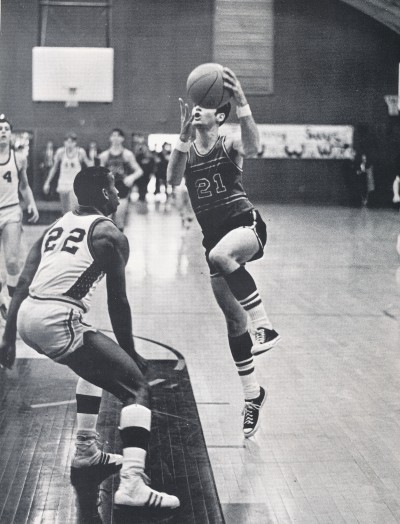 |
The Seventies... and then
the Eighties
My own awakening did not take
place until after college. In 1972, I had an
unusual summer job maintaining the Houston city parks.
This was a rather humble job considering I was a recent
college graduate, but I was new back in town and this
was good enough until graduate school came along.
The workmates in my crew were five
black men, each one a Vietnam vet. I was the only
white guy. They were just as curious about me as I
was about them. We had some very interesting
conversations. That summer I got quite an education on
how African-American men are treated in modern-day
America.
For my graduation exercise, I was
told to go see a movie titled The Liberation of L.B.
Jones. The movie was about the ruthless
assassination of an innocent black man by two white
cops.
I might add I was the only white
person in a theater with at least 100 blacks. No
one said a word to me, but the hostile looks I got spoke
volumes about the bitterness caused by two centuries of
oppression. After leaving the theater, my
education on racism was complete to say the least.
|
 |
However, my new-found enlightenment did not
lead me to think of Saint John's. As far as Saint John's
and its Rebel mascot was concerned, nothing could have been
further from my mind.
I was headed for graduate school. I heard a rumor from a classmate that Saint Johns had decided to
integrate in the early Seventies.
I do not know if that actually took
place, but I
hoped it did. If so, I assumed at this point it would be a good
time to phase out the mascot. Right?
Wrong. Saint Johns remained the Rebels
throughout the Seventies. And the Eighties too.
|
1990: I VISIT THE SAINT JOHN'S CAMPUS
Fast Forward to 1990. To be honest, I
forgot about the Mascot problem for twenty years. Out of
sight, out of mind.
In the
Seventies I finished college, went
to graduate school, then rode the
energy of Saturday Night Fever to
start my career as a dance teacher.
The
Eighties went by fast as I worked to build my business.
One day in 1990 I
was asked to teach some adult education
dance classes on
the Saint
Johns campus during the evening.
Nostalgic to see the school that had meant so much to me for nine
years, for my first evening
back, I arrived a couple hours
early to
look around. It was time I had set foot on campus since
graduation in 1968. Oh sure, I had driven by now and
then and
marveled at all the new construction from afar, but I didn't have a reason to
actually put foot on the campus.
As I strolled around, I
was pleased to notice several handsome, alert young men
who just happened to also be black.
Good. And I noticed several lovely young women, just as
alert, who also happened to be black.
Excellent. I was
equally pleased to
notice quite a few Asian and Arabic students as well.
As I walked across the campus
I could see all of these
non-white students seemed quite comfortable wearing their Saint Johns
uniform. Saint
Johns was clearly at the forefront of social change in this regard.
At that moment, I had never been more proud of my school.
And then I smiled as a pretty cheerleader
walked by. But then I saw the name "Saint Johns Rebels" on
her cheerleader's
outfit and completely froze. I was stunned
by the surprise.
|
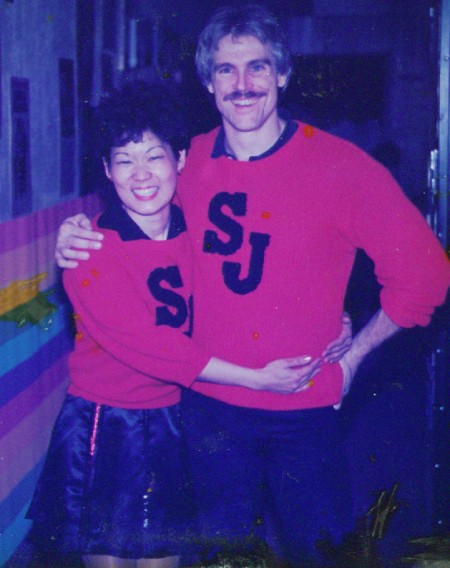 |
This can't be right. I had taken
it for granted the nickname had been phased out.
You have got to be kidding.
I shook my head in disgust.
I could not imagine why someone in authority hadn't put their foot
down and done something about this nightmare nickname
long ago.
How could the Saint Johns
administration and trustees
turn a blind eye to a problem of this magnitude?
In my opinion, the name was already an anachronism in
the Sixties.
That was over twenty-five years ago!
As I watched a black SJS student talking with
his friends, I could see the young man felt right at home at the
school. Then an odd thought crossed my mind. I wondered
how this young man would feel... and how the white students would feel... when
the day came to study the Civil War in American History class.
Would the subject of "We're Proud to Be Rebels" come up?
If so, just how exactly would the teacher handle this particular
awkward moment?
Here is what I did not know. According
to Wikipedia, in 1990 the Upper School students voted to
discontinue the mascot and nickname. A year later, all symbols of
the Confederacy were disassociated from the School, although the
nickname "Rebels" was retained with the hopes it could be connected
with the American Revolution or more generally as an invocation of
nonconformity and independent thinking.
I never knew this at the time, not learning of
these events until 2013 when I updated my own story.
So I stand corrected. Someone indeed was
trying to deal with the problem.
Unfortunately, I imagine to an outsider the
Rebel nickname would still raise automatic skepticism.
It was probably not a good idea to stick with the Rebel nickname
even though it had been sanitized. Why take the chance of
letting a misunderstanding give someone the wrong impression about
the school's excellent reputation?
Let's Look at This Problem From Another Point of
View
|
Think about this issue as
an African-American mother and father would.
Both parents are descendants of
former slaves. Both parents are also college-educated
professionals. They are debating whether to send
their talented son
or daughter to a school
whose nickname represents images of the Civil War,
the bloodiest, most horrible
era in American
history.
As the parents await an interview at
the school, they are already uneasy about the "Rebel"
nickname. If these parents take
one look at the Rebel Mascot, who would blame them if they politely
excused themselves from the interview and left the campus?
One can assume these same
parents would do everything in their power to find an
equivalent school elsewhere. Surely there
must be another school in Houston where their child would
feel more welcome. Why take the
chance of subjecting their child to racial prejudice?
Now if these same parents were to talk to me, I would tell them that
Saint Johns is one of the most enlightened schools in the city.
I would tell these parents that despite the mascot, Saint Johns is color-blind. And
that opinion would be the truth as I know it.
But that "Rebel"
nickname would still be staring them in the face giving them
second thoughts. Who could blame them? To
an outsider, the nickname
clearly suggests the school
tacitly harbors racist
attitudes. As they say, actions speak louder than
words.
|
 |
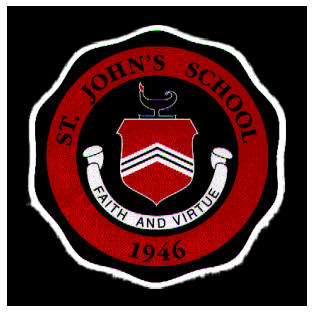 |
It would be a shame if anyone thought that my
school was prejudiced. The Saint John's of my memory was ahead
of its time. Maybe there was a racist side to Saint Johns
in the Sixties and I was just too young to see it. But as I
said, quite honestly I don't recall a single bigoted statement or
incident in my entire nine years at Saint John's.
I will gladly give my school the benefit
of the doubt in the Sixties. Attitudes were changing.
And I can forgive the Seventies as well. Traditions don't go
away that easily.
But the Eighties? And the
Nineties? And then on into the next Century? C'mon now. What possible
reason could anyone use to justify clinging to this divisive image?
I understand very clearly what the image of
the Confederate Rebel stood for. This was a brave man who
stood up and fought for what he believed in, something we can all
admire. His image would naturally be a source of pride to
many. 'The Rebels' was a cool nickname in
its day, but its time had passed.
Why should the school take a chance that an
outdated symbol could give any outsider the wrong impression?
|
On a personal note, I have always
admired the military prowess of the South. Those Rebels
could really fight! In many battles they badly
embarrassed the larger, better equipped forces of the North.
And I admire the military genius of Robert E. Lee and
Stonewall Jackson. They danced rings around the North.
If Jackson had not died of the freak accident, who knows
what would have happened?
I can definitely see why the Rebel
Spirit makes these men heroes to many. I don't agree
with their position on slavery, but I can definitely respect
the courage the soldiers fought with. They were brave
men and I understand that they fought for what they believed
in.
I am simply saying that a black man or
a black woman should hardly be expected to share in this
pride.
To an African-American, at the most basic level, a Rebel was a man who fought
for the right to continue slavery, the repugnant practice that assumed
a human being was worthy of bondage due to the color of
his skin.
To them, the Rebel flag and the Rebel
soldier would stand for an era when black slaves were often
treated with less dignity and respect than most animals.
The memories of their descendants would be much different.... whippings,
beatings, rapes, lynching, and frightened children sold to
other estates. They would remember the constant
humiliation of being treated as property, as less than
human.
|
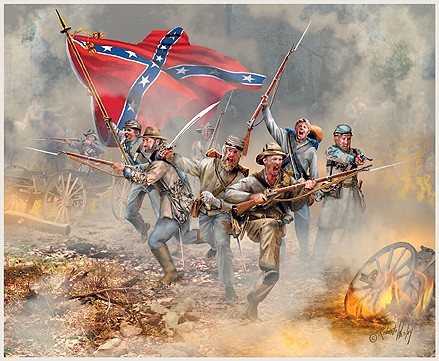 |
The Nineties
As the turn of the century approached, Houston had come a long
way towards putting its racist ways in the rearview mirror. As
racial tensions in our city eased, Houston
was now a modern city well on its way to
becoming an International power. We had a
black police chief in the Eighties. We had a black mayor in
the Nineties. We would have a gay mayor in the 2000s.
Houston wasn't just keeping up with the times, it had become a
national leader.
But Saint John's was still the Rebels.
Surely at this point someone in
the school would
be uncomfortable with the Rebel mascot. Didn't
anyone see the disconnect between the prevalent social
consciousness of the Nineties versus the school's mascot that conjured
images of racism, cruelty, and slavery? Apparently not.
Or more likely
no one had the guts to stand up and say something. That's my guess.
Nor can I blame them. I certainly
didn't say anything, so who am I to point fingers?
I imagine behind closed doors the subject was
gingerly discussed, but it could not have been easy dealing with the
"Traditionalists".
I have little doubt the campaign to change the
nickname was an ongoing uphill struggle. The supporters of the
Rebel Mascot would surely wrap themselves in the cloak of
"Tradition" and defend the Rebel name's continued use as a symbol that connects the school's past
to the present.
THE DAWN OF THE MILLENNIUM
|
Although the SJS mascot made it past the Millennium, by now its days were numbered.
In 2004 the issue of the nickname was finally
addressed in a public forum.
Early in 2004, various Saint Johns Alumni
like myself were sent letters asking them what they thought about the Rebel nickname.
Apparently the
current Headmaster, John Allman, was doing everything in his power to
spearhead the change.
On January 12th of 2004, I put my two cents in:
"You have my vote to change the "Rebel" name and I hope you do it
quickly. It is, as they say, an anachronism.
The Rebel name has absolutely no relevance in today's understanding.
For any person with half a brain it is an ugly symbol of the darkest
period in American History. To an outsider, it hints strongly of the
school's support for racism.
I know for sure the school does not support or condone racism in any
shape or form, so why open the door for senseless misunderstandings?"
One month later on Wednesday, February 18, 2004, I received the following news:
Dear Friends:
For the past several months, our School community has been reflecting
on the significance and values communicated through our mascot.
Deliberating this issue has given us the opportunity to examine the
values that St. John's represents and to contemplate best how we
express those values. St. John's today is a better school for having
accepted this challenge and for having come to a decision together.
The Board of Trustees sought input from you: alumni, students,
faculty, parents, and friends. With all voices heard, the time has
come for a resolution that will enable St. John's to move forward. The
Board has unanimously decided to select a new mascot, one that
inspires affiliation, unity, and commitment within the St. John's
community. In so doing, our school has the opportunity to find the
right mascot to project our core identity to those outside the
community. The following points guided our decision:
. Mascots are meant to unify. They are not meant to divide.
. A mascot that must be explained does not adequately represent a
school.
. Our current mascot leads some to question our values and commitment
to diversity.
. A mascot that demeans members of our community is inappropriate.
This week, a committee of students, alumni, faculty, and friends will
be formed to direct an inclusive process for selecting a new mascot
that will incorporate the school's traditional red and black colors.
While the Board will approve the committee's selection of the new
mascot, we encourage you to participate in this process by suggesting
ideas that will rally our entire school community. The committee will
soon let you know how you can get involved.
Ultimately, the committee must select a mascot that has broad appeal
among students, alumni, and friends of all ages. Ideally, we would
like the selection process to be completed before summer vacation
begins, but we will take all the time needed to select the right
mascot. Our School deserves a mascot everyone can support.
In making this decision, St. John's is not abandoning tradition, but
seeking to confirm and project more accurately our school's most
precious traditions and values. A new mascot can now bring together
everyone in our community, convey the mission and vision of our
school, and invite in new members whose contributions to St. John's
will enrich us all.
Every Board member believes that this decision is in the best
long-term interest of St. John's School, and we are hopeful that the
process of selecting a new mascot will unify our community.
Respectfully yours,
James A. Elkins, III
Chairman, Board of Trustees
February 18, 2004
I got goose bumps reading this eloquent letter. Somebody put a
lot of thought into this effort.
I immediately sent the following letter to Mr. Allman, the Headmaster.
"Aha! Rebels no more. Thank you, Mr. Allman.
It is my understanding that you personally took on the challenge to
bring St. Johns to its senses and help us get rid of the
awkward "Johnny Reb"
image. Congratulations on your success!
I have been ashamed of this name for about 30 years ever since I was
old enough to realize what an affront the name was. For such an
obvious move to have taken this long to bring about would make for an
excellent tale, but I suppose we will never hear the inside story of
the obstacles I imagine you were forced to
overcome. I am so glad you stayed with this issue. You have every
right to be proud of what you have helped to accomplish. And good for
the Board to back this change unanimously.
I met you briefly this past fall at an Alumni Reunion. Had I been
aware of the stand you were taking on this issue I would have taken
the opportunity to thank you personally. You have proven your
leadership ability. You can count on my support for any more changes you think is
necessary to move Saint Johns forward. Thank you again.
Rick Archer"
I have never been more proud of my school than I
was that day on February 18, 2004.
They finally got it right!
I guess social change is never graceful. Actually I think they got it
right when they hired Mr. Allman.
Isn't it marvelous what a good
leader can accomplish?
FOOTNOTE: MEET
THE SAINT JOHNS MAVERICKS!!
Now it was time to find a new mascot.
They went with Mavericks as
the new name. At the time, I wasn't particularly
thrilled with the name "Mavericks". However, my
attitude changed the moment I saw the new logo. Wow!
My first thought was someone did a great job! I was
really impressed.
 |
Then I took a look at who designed it.
It was none
other than Lindon Leader, a classmate of mine from the Class
of 1968. We all knew Lindon had a genius for design back
when he was our classmate. Lindon is responsible for
the classic Fed Ex logo.
I smiled at the knowledge that Lindon had shared his
talents with us once again.
|
|
Lindon wrote this about his Maverick logo.
St. John’s School
Houston, TX
For 60 years, St. John’s School teams were the
“Rebels.” Yielding to contemporary political
correctness and pressure from many colleges and
universities, the School’s board of trustees
determined a name change was in order.
Leader Creative developed a graphic identity and
implementation program for the newly renamed
“Mavericks,” helping to overcome significant
internal resistance from many students, parents and
alumni reluctant to give up their long beloved
“Rebels.”
Note: here
is some of Lindon's other work. Fascinating!
I also noticed that Lindon didn't bother with a current
picture, so here's one from our Senior year.
|
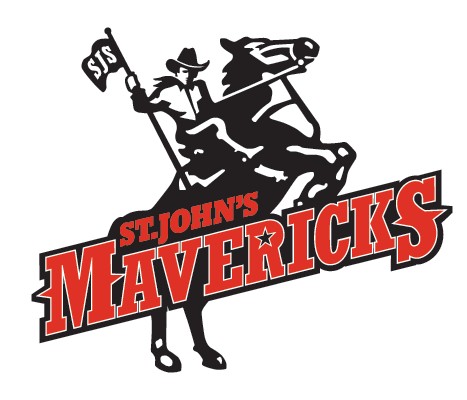 |
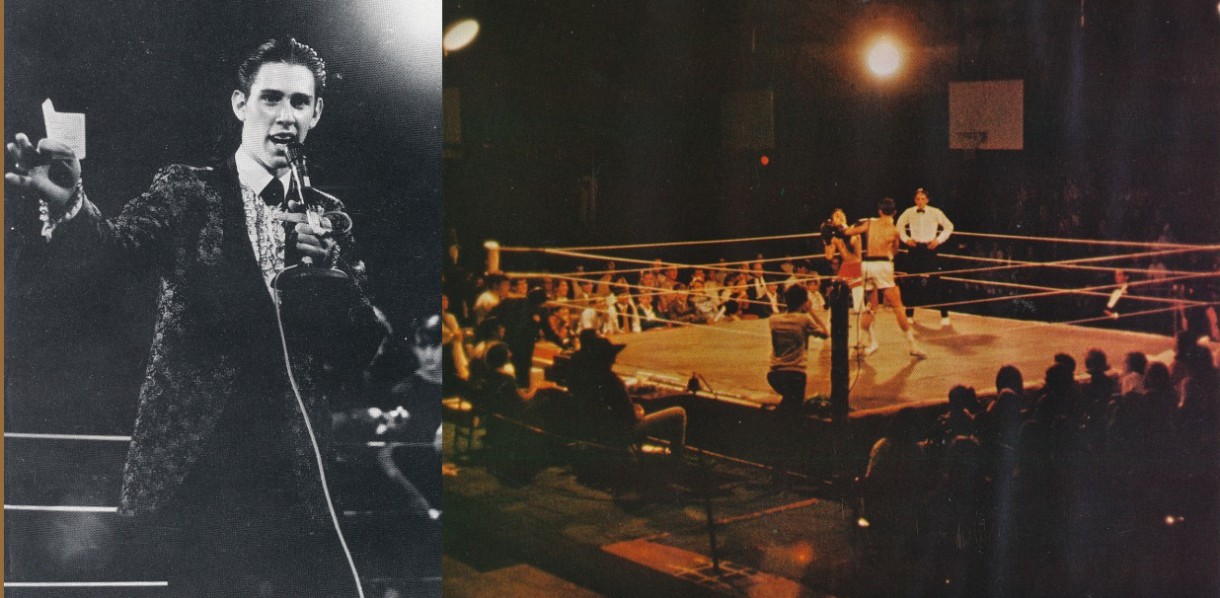 |
That's Lindon Leader serving as the announcer
for a boxing match sponsored by the Class of 1968. I
always liked Lindon's slicked-back hair. He made me laugh.
This is a very
intriguing story. One day in the Senior Lounge, Lindon and
several of his friends decided to build a full-sized ring
in the school's basketball gym and have a fight card
with three matches. It may sound goofy, but the
event was very realistic. They got
some guys to train and some pretty girls to dress up as fight babes.
They did a great job of promoting
the event. That gym was sold out and those fights
were a lot more serious than I expected. Those
were real punches thrown and when they landed, they
hurt! Each young man definitely fought to
win.
I never thought to ask at the
time, but someday I want to find out how they ever got the SJS
administration to sign off on this brilliant lunacy.
|
|
|
|
|
Rebels in Other
Parts of the Universe
|
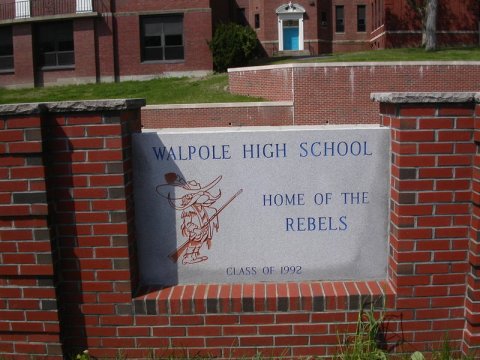 |
2007 Walpole
Rebel Controversy in Masschusetts
On February 12, 2007, I received the following email.
-----Original Message-----
From: MICHAEL AMARAL
Sent: Monday, February 12, 2007 4:20 AM
To: dance@ssqq.com
Subject: link on my blog to your website...
Dear sir:
I hope you don’t mind...I’ve made a link to your website on
my blog.
http://walpolemassachusetts.blogspot.com/2007/02/i-am-not-aloneperspectives-on-rebel.html
thank you for your honest perspective!
Mike Amaral |
I visited Mr. Amaral's page and
discovered he was embroiled in a dispute to get rid of
the "Rebel" name from his own high school in Walpole,
Massachusetts.
I was surprised to see he didn't quote a single thing I
said. Instead he went straight to the eloquent
letter signed by James Elkins on February 18, 2004.
On Mr. Amaral's web site I read:
".....The Board has unanimously decided to select
a new mascot, one that inspires affiliation, unity,
and commitment within the St. John's community. In
so doing, our school has the opportunity to find the
right mascot to project our core identity to those
outside the community.
The following points guided our decision:
Mascots are meant to unify. They are not meant to
divide.
A mascot that must be explained does not adequately
represent a school.
Our current mascot leads some to question our values
and commitment to diversity.
A mascot that demeans members of our community is
inappropriate."
In other words, the wise decision
made by the Saint Johns community in 2004 might help Mr.
Amaral bring the people in Walpole to their senses as
well. I am rooting for Michael.
2009 - STILL NO PROGRESS AT
WALPOLE
Rick Archer's Note: I received an
email from Michael Amaral that expressed his frustration
at the lack of progress in changing the Rebel Mascot at
his own school.
He asked if I would say something,
so I posted this letter on his
website:
From:
Rick Archer
Sent: Thursday, May 07, 2009 1:09 PM
To: 'MICHAEL AMARAL'
Subject: RE: rebel update, walpole massachusetts
TITLE: in reference to the Walpole
Rebel Mascot
My name is Rick Archer. I am a 1968 graduate of Saint John's
School here in Houston, Texas.
During my years at SJS back in the Sixties, we were the Rebels
complete with a giant Johnny Reb mascot.
In 2004, our administration decided it was time to change the
mascot. For the past five years, we have been the
Mavericks. The change was achieved with a minimum
of fuss; everyone agreed it was long overdue.
I have never been more proud of my school.
The two darkest periods in American history were the brutal
extermination of the American Indians and the
slavery of the Africans. Any references to either
shameful period is offensive to many people.
Today schools across the country - Stanford University for
example - are exchanging their Indian mascots for
new ones. Likewise a similar fate for schools with
'Rebel' mascots.
For example, in addition to my own high school, I see the Denver
(Colorado) South High School dropped their Rebel
mascot in 2009.
A similar thing has happened at Dixie State College in Utah in
2009.
"Dixie State College trustees voted to retire the school's Rebel
nickname and mascot symbol because they are
associated with Old South stereotypes invoking
slavery and the rebel Confederacy."
Yes, there were protests over the name changes. Personally
speaking, I will always respect the courage of the
underdog soldiers who fought for the Confederacy
against all odds. I have long admired Jackson and
Lee as amazing military leaders.
But the entire concept of 'slavery' sickens me nonetheless. And
that is the deciding factor here. Slavery is
wrong. End of debate. Anything that reminds us of
this period belongs in history books or museums, but
not as a public symbol.
Of course it hurts to let go of tradition, but it feels better to
do the right thing.
A school's mascot is meant to unify, not offend.
|
2013
Update: Walpole is still the Rebels:
Confederate flag near
Walpole HS sparks debate
Posted: 05/26/10
|
WALPOLE, Mass. -- The Confederate flag is at
the center of a growing controversy in Walpole.
The Confederate flag, considered by many to
stand for the Old South’s fight for slavery, was
the symbol of Walpole sports teams for decades.
The football team is still known as the Walpole
High School Rebels.
The Walpole School board voted in 1994 to do
away with the divisive symbol after a 25-year
run.
As for the flag, “I
don’t really like it. I think it should go
down,” said Marven Jensimon.
Yet the flag is still being displayed on private
property right next to the Walpole High School
football field.
Property owner Joe Finneran says he does not
want to remove the flag.
“It’s a whole lot of horse manure… If it bothers
some people, too bad,” he said.
Finneran claims a friend asked him to put up the
flag at the end of last summer in time for the
football season.
“The kids loved it, and they were all having
their pictures taken. Hundreds and hundreds of
kids were taking photographs with the flag,” he
said.
Yearbooks from the late 1960s contain
photographs of the Confederate flag, displayed
on the sports field and spray-painted on rival
Dedham High School as a prank.
Finneran, a member of the class of 1969, was
a Rebel football player and went on to serve his
country in Vietnam.
“Only I and the Almighty know if there’s an evil
in my art. As long as I’m OK with him, let
everybody else take a hike,” he said.
|
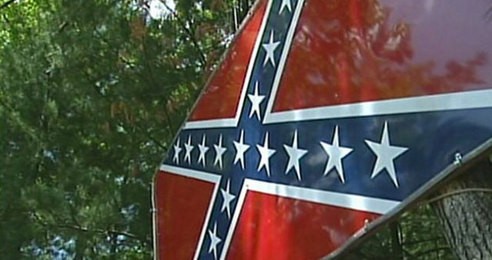
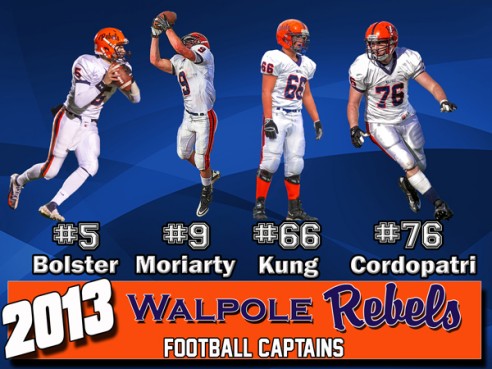 |
Students and
athletes today largely support the symbol.
“I don’t know. It’s just a symbol, There’s all
kinds of symbols out there,” said Judy Feldman,
one local woman.
Other teens are passing around a petition to
get rid of the flag.
“I think the flag is completely inappropriate.
It should not be a symbol for our school. It
basically represents racism,” added Ara
Nerssessian, who did a project on the flag.
The Walpole school system released a statement
acknowledging the flag’s divisiveness.
“The school district makes an announcement prior
to athletic events explaining that the flag’s
display is not endorsed by the district,” said
Superintendent Lincoln Lynch.
A lawyer for the school system who helped draft
the statement said there is not much the school
can do, because government entities are
prohibited by law from abridging a private
citizen’s right express himself or herself.
Source of Story
|
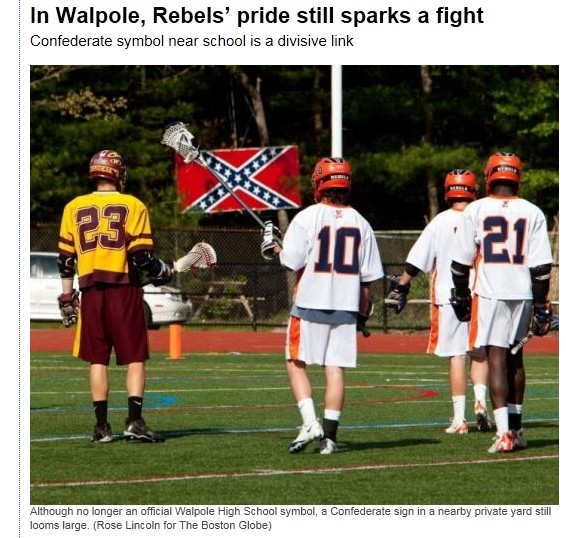
Although no longer an official Walpole High School
symbol,
a Confederate sign in a nearby private yard still
looms large.
(Rose Lincoln for The Boston Globe) |
Confederate symbol near
school is a divisive link
By Peter Schworm
Globe Staff / May 25, 2010
WALPOLE — Past clapboard houses with white
fences, in a tree-filled yard next to the local
high school is an unusual sight: a large sign
painted to look like a Confederate flag.
In most other parts of the country the flag is a
searingly divisive symbol of racial segregation.
But here, it is also a display of pride for the
Walpole High School Rebels.
For years, Confederate flags filled the
bleachers at football games while fans sang
“Dixie,’’ the Old South anthem. Yearbooks were
emblazoned with the flag, and a celebrated coach
went by the nickname General Lee.
Most of that ended in 1994, when school
officials declared the flag an inappropriate
symbol and eliminated it as an unofficial team
emblem. But affection for the flag has lingered,
and in the fall it appeared in the neighboring
yard, resurrecting what some say is an
uncomfortable era in the school’s history. Games
at cozy Turco Memorial Field now come with a
disclaimer, read to the crowd to preempt tension
and distance the school from the controversial
display.
“The Walpole School Committee apologizes to
anyone who may be offended by the private
citizen who chooses to display a Confederate
flag in close proximity to the Walpole High
School field,’’ the message goes. “It in no way
reflects values that we support.’’
School officials rue the flag’s presence, but
say the neighbor who hung the flag from a tree
in his backyard, a Walpole High School student
in the 1960s, has the right to display it on his
property. The owner of the house where the sign
is displayed could not be reached for comment.
|
“We wish this proud Rebel would take it down,’’
said John Desmond, chairman of the school board.
“It’s unfortunate it was ever used.’’
Many in town say fondness for the flag, which
for years was emblazoned on the team’s uniforms,
runs far deeper than one defiant graduate. From
the 1960s, when a coach named John Lee came from
Tennessee to lift the team to prominence, until
the school dropped the symbol in 1994,
Confederate flags were flown openly at games,
and team photos were taken in front of a large
mural of a flag near the field.
Even today, when the blue-crossed Confederate
flag is widely seen as a painful reminder of the
nation’s history of racial injustice, the
occasional fan will wave the banner from the
stands, as they did at a 2008 championship game
at Gillette Stadium.
“The cover of my yearbook was a Confederate
flag,’’ recalled Mike Amaral, a 1971 graduate
who laments the school’s strong affiliation with
the flag and has urged the school to choose a
new mascot. “Some people can’t seem to let that
go.’’
For supporters, the Rebel nickname and the flag
symbolize school spirit, and serve as an
important link to the school’s past. Walpole
could hardly be less Southern, but some
interpret the flag as some white Southerners do,
as an expression of pride, valor, and
determination.
That has been especially true for the football
team, which has won an impressive 20 league
championships and seven Super Bowls, and had
numerous undefeated seasons in the past four
decades.
“It’s pride, not prejudice,’’ said Dylan Murphy,
a junior, and one of a number of students who
support the Rebel nickname and flag. “That’s
what it means to us.’’
Murphy said some students waved a Confederate
flag at a football game last fall, but a coach
quickly spotted it and stormed into the stands
to take it away.
One black student at Walpole High, quoted in a
video report by the school newspaper, The
Rebellion, said she is not bothered by the
flag’s use at games because “I know people in
the school are not using it against me.’’ But
another said, “As a man of color, I find it
offensive.’’
Others agree the flag is offensive, at least to
some. But they regard the Rebel nickname as
sacrosanct and view efforts to discard it as
mere political correctness. That is especially
true among students.
“It’s Rebel pride,’’ said Will Krumpholz, 15,
who added that “players like it more than their
parents.’’
Walpole High adopted the Rebels’ moniker —
replacing its old mascot, the Hilltoppers — in
the mid-1960s, at the centennial of the Civil
War and amid the bitter strife of the civil
rights movement. At first the nickname carried
no connection to the Confederacy. But when John
Lee took over as coach in 1968, the Rebels
fandom took on a distinctly Old South tone.
Newspapers called the team “General Lee’s
Rebels,’’ and Confederate flags became popular.
In yearbook pictures from the era, flags fill
the stands. Such images continued well into the
1980s.
“To speak against it was to speak against the
team,’’ said Charles Hardy, a longtime social
studies teacher at the high school who retired
in 2002. “It always seemed pretty insensitive,
but people just persisted with it.’’
In the latter part of that decade, a group from
the New England Association of Schools and
Colleges expressed concern about the use of
Confederate flags, saying the banners “may be
inappropriate due to its historical
ramifications.’’ That led to the end of its
official use as a symbol.
But debate over the nickname persists. When
asked about the flag, school officials barely
deviate from prewritten statements.
Amaral, a member of the town’s historical
commission, said the nickname trivializes Civil
War history, romanticizes the Confederacy, and
dishonors the sacrifice of Union soldiers,
particularly those from Walpole who died for
their country.
“This isn’t our history, it’s somebody else’s,’’
he said. “And these are heroes that deserve
better.’’
(source
of story)
Rick Archer's Note:
This story has a strange
coincidence to it. I find it very
eerie that Walpole became the Rebels in the
Sixties when they got a football coach named
"Lee". Longtime Saint John's alumni
like myself will recall with fondness our
very own football coach was Skip Lee.
In fact, our football field is now named for
Coach Lee.
That odd factor somehow links these two
stories. Two schools had the same
problem with the Rebel mascot. One
school broke from its past, the other school
is still mired in controversy 20 years later
because they did not get rid of the "Rebel"
nickname.
Reading these stories, I am struck by the
fact that this entire town of Walpole is
divided over this "Rebel" issue. I
think both articles speak to the fact that
whether we like it or not, racism continues
to exist in our country. Can you
imagine the reaction if someone suddenly
began waving the Confederate flag at SJS
football games?
Had it not been for the wisdom of John
Allman, these same arguments might still
plague Saint John's today.
I do not know the inside story of Mr.
Allman's quest, but I would be fascinated to
read his account someday.
That said, I think the collective Saint
John's community should be grateful that Mr.
Allman led the way to free our school from
the dark legacy of the Civil War.
And compliments to the Saint John's Board of
Directors as well.
Rick Archer
September 2013
|
|
|
|
|